I grew up in a home blanketed by carpets, and, wow, am I ever a fan of hardwood floors now! If you do it right, hardwood floors can last half a century. This makes hardwood a much more sustainable flooring option than carpets that wear out in just a few years. Here are my top picks for sustainable hardwoods.
Table of Contents
Compared to carpet and linoleum, hardwood floors are easier to keep clean and much more durable and sustainable. This makes hardwood a great choice for eco-friendly renos and if you have pets, kids, allergies, or a combination thereof.
At first glance, a straight plank of wood looks like the cleanest, greenest option for hardwood flooring. However, engineered wood flooring actually uses much less of a tree per plank than solid hardwood.
If you already have hardwood floors check to see if you can refinish these first instead of replacing the floor entirely. This is the most sustainable (and affordable) option. When buying new, look for hardwood flooring made with 100% FSC certified wood that you can install and maintain without requiring solvent-based products.
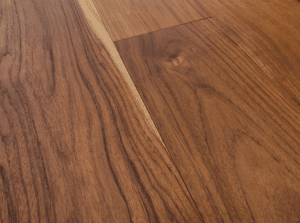
Best eco-friendly teak flooring option
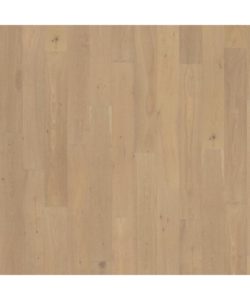
Best sustainable oak flooring option
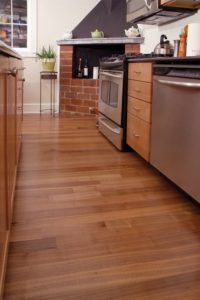
Sustainable hardwood flooring runner up
What is ethical hardwood flooring?
Ethical and sustainable hardwood flooring comes from forests that are managed, monitored, and protected. This ensures that trees grow for future generations. Eco-friendly hardwood flooring is also manufactured with fewer toxic chemicals in a way that won’t compromise indoor air quality.
Unfortunately, some ‘green’ flooring is just a greenwashed toxic unsustainable product. And, counterintuitively, the most sustainable flooring is sometimes that which looks the least sustainable right out of the box. Why? Because ‘natural’ flooring might necessitate greater use of toxic adhesives or finishes overall.
What’s more, some manufacturers use the FSC logo rather creatively. It’s easy to assume that an FSC logo means an entire product or collection is sustainable. However, this isn’t the whole truth. For a complete deep dive into the most important certifications for sourcing ethical hardwood floors, see this post.
In the list below, I cut to the chase, and offer my top picks for guilt free, climate friendly, hardwood flooring.
The best eco-friendly hardwood flooring: our top picks

Galleher Monarch True Teak Collection
Highlights: Easy to maintain, fully FSC certified sustainably sourced teak flooring. Made with E0 certified Baltic Birch plywood backing and formaldehyde-free adhesives.
Galleher’s True Teak collection offers luxury hardwood flooring made exclusively from FSC® certified older growth plantation teak in Thailand. The teak is glued to E0 certified Baltic Birch plywood backing using formaldehyde-free adhesive. The final product is exceptionally durable and resistant to rot and moisture-related expansion and contraction.
Historically, teak has been massively overharvested, decimating forests in South East Asia. Many newer plantations harvest wood when trees are 10-15 years old. Galleher exclusively sources mature 25-30 year-old Tectona grandis teak from well-managed FSC certified plantations in Thailand.
This collection includes Sunned Teak Prime, Bleached Teak Prime, Sunned Teak Light Rustic, and Bleached Teak Light Rustic. The flooring has a UV cured urethane finish that is easy to maintain without the need for toxic chemicals. The flooring comes with a lifetime structural warranty and a 25-year residential finish warranty (3 years for light commercial). You can install this as a floating floor or use nail-down or glue-down methods.

Kahrs Original, Prime
Highlights: Made in Sweden using local FSC certified wood. This one-strip, wide-plank floating hardwood oak flooring has a matte finish and is free from aluminum oxide or toxic glues or finishes.
Kahrs Original Prime flooring is made in Sweden using wood from Eastern Europe, helping to reduce transport associated emissions. The UV cured acrylic finish is water-based and the Prime Collection is made without urea formaldehyde glue. This one-strip hardwood collection exceeds CARB2 and European standards for off-gassing; formaldehyde tests show 0.008 ppm. It is also EMAS and FloorScore qualified and meets Prop 65 requirements. Kahrs is a U.S. Green Building Council (USGBC) Member.
The Prime collection looks more modern and sophisticated than the European Naturals collection and the wire-brushed finish looks oiled even though it’s not. The white oak has a matte sheen and slightly grey appearance which will change over time. There’s no Janka hardness rating available for this flooring. The stated 3.7 Brinell hardness rating is roughly equivalent to 830 Janka, however.
The planks are 9/16ths of an inch (14.2 mm) thick with a 1/8th inch (3.5 mm) top/wear layer, making these a bit thicker than Tesoro Woods. This means you can sand the flooring two to three times. The planks are 7.5 inches wide, and 73.25 inches long, making these a bigger board than Tesoro Woods offers.
Kahrs DIY installation system makes it easy to lay your new micro-beveled floor yourself. This can save you time and money and doesn’t require toxic glues and so forth. The Kahrs 30-year wear-through warranty and lifetime structural warranty also offers good peace of mind. This floor is also warranted for radiant-heated floors over both hydronic and radiant heat.
This product qualifies for LEED: Indoor Environmental Quality/4.4 Low-Emitting Materials – Composite Wood and Agrifiber: 1 point, Indoor Environmental Quality/4.4 Low-Emitting Materials/No added Urea-Formaldehyde: 1 point.

Tesoro Woods Great Northern Woods – FSC Certified
Highlights: Knot-free, FSC Mixed 3-inch or 5-inch wide, E0 compliant, zero-VOC engineered hardwood flooring made with Select grade American hardwood.
Tesoro Woods Great Northern Woods hardwood flooring collection comprises FSC certified sustainable American hardwood from Select grade timber. The collection includes rift or quarter-sawn maple, walnut, red oak, and white oak as 3-inch or 5-inch wide planks. It comes in boxes of random lengths from 11 to 84 inches long.
These strips are tongue and grooved for easy laying. You can float, nail, or glue down the pieces, which have no added urea formaldehyde adhesives. The flooring has zero VOC finishes and is E0 compliant. All Great Northern Woods flooring products are plantation grown in certified controlled forests. The wood has no knots or mineral streaks, so every piece is good to be on full view.
The planks consist of certified sustainably harvested hardwood. The core and bottom come from either recycled, reclaimed, or salvaged sources. Tesoro Woods offers a 27-year residential wear-through warranty and a lifetime structural warranty. Each piece measures 14.29 mm thick and the veneer is 3.2 mm thick, offering potential for a couple of sandings.
This collection qualifies for a variety of LEED points including for 4.4 Low-Emitting Materials, No added Urea-Formaldehyde: 1 point, Materials & Resources, and 7 Certified Wood: 1 point. It is also certified by FloorScore, FSC 100% Mixed, E0 compliant, isocyanine-free, and CARB 2 certified.
The wood is UV finished with aluminum oxide enhanced urethane with a water base and a smooth matte finish. It has a Janka hardness rating of 950, which is pretty high for engineered wood.
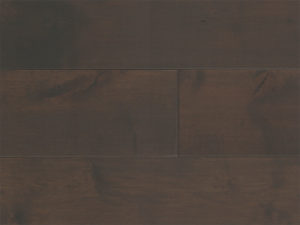
Tesoro Woods Coastal Lowlands – FSC Certified
Highlights: Non-toxic, E0 compliant, 100% FSC certified, 7-inch rustic hardwood flooring in a matte finish and suitable for at least two sandings.
Tesoro Woods Coastal Lowlands collection comprises 100% FSC Recycled certified wide plank (7 inch) rustic hardwood flooring. It is made in Guatemala using North American maple, walnut, white oak, and hickory with an engineered core and back of plantation grown pine from Chile and Brazil. The flooring has a 3 mm sawn wear layer on a solid cross slat core in a 3-layer format.
Coastal Lowlands is a tongue and groove hardwood flooring system that you can nail, glue, or float. It is suitable for use at or below grade and you can use it over hydronic radiant heat systems. The planks are finished with UV cured Aluminum Oxide enhanced open grain urethane and don’t off-gas any VOCs.
This flooring qualifies for Floorscore and LEED under Indoor Environmental Quality/4.4 Low-Emitting Materials/No added Urea-Formaldehyde: 1 point, Materials & Resources/7 Certified Wood: 1 point. It is also E0 compliant and free of isocyanine.
The planks measure 7 inches wide, 12-84 inches long, and 9/16ths of an inch (13.6 mm) thick with a 3.2 mm top/wear layer that allows for two sandings. The maple and walnut have a smooth surface while the hickory and white oak are lightly wire-brushed. There are 14 shades available, and these planks can include knots, mineral streaks, and micro-beveled edges making them a great fit if you’re after a quick installation and a shabby chic aesthetic.
Like other Tesoro Woods products, this flooring option has no add urea formaldehyde adhesives. It is a good option if you’re chemically sensitive and is durable and easy to maintain thanks to the thick wear layer. It also comes with a lifetime structural residential warranty with a 27-year warranty on the finish.
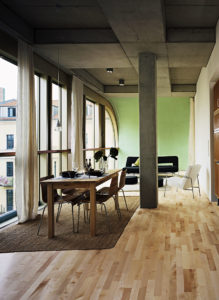
Kahrs Original, European Naturals – FSC Certified Oak Siena
Highlights: European-style floating hardwood flooring perfect over hydronic or electric radiant heat and in dry or damp spaces. CARB2 compliant, made with FSC certified oak (also available as maple, walnut, cherry, pecan, and other species) engineered with non-toxic adhesives and finishes.
Kahrs hardwood flooring is a 3-layer engineered design with a silk matte hardwood top/wear layer, quartersawn pine or spruce core, and a softwood bottom layer. It has a UV cured acrylic/urethane low-VOC finish and is made with formaldehyde-free adhesive. The flooring is CARB2 compliant and FSC Mixed Sources certified with raw materials sourced within 200 km of the Kahrs factory in Sweden.
This product also meets EMAS standards as well as environmental management systems ISO 14001 and 9001:2000, and California Proposition 65 requirements. The finish doesn’t contain aluminum oxide, making it suitable for a variety of refinishing products.
Kahrs has been around for more than 150 years and specializes in stable, durable flooring. The company seasons wood slowly and carefully over six months to two years Combined with the cross-ply structure, this extended drying makes it a great choice for even super dry or damp climates. Kahrs is also great for use over radiant heat, with no buckling or warping. You can use these boards on concrete and wood subfloors in all rooms.
The Kahrs European Naturals Collection offers a more traditional aesthetic using maple and oak from the Alps. It has a square edge design and is easy to install, even for amateur DIYers because it uses Kahrs patented Woodloc interlocking system. No nails or glue needed!
The planks are 5/8ths of an inch (15 mm) thick with a 1/8th inch (3.5 mm) top/wear layer, making these a bit thicker than Tesoro Woods. This means the flooring can be sanded two to three times to restore the unstained white oak matte finish. The planks are 0.63 inches (15.9 mm) thick, 7.88 inches wide, and 95.38 inches long, making these a bigger board than Tesoro Woods offers.
Kahrs flooring comes with a 25-year wear-through warranty and a lifetime residential structural warranty.
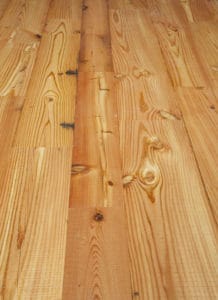
Wide Plank Floor Supply Reclaimed Heart Pine Plank Flooring
Highlights: Hardwearing rustic looking reclaimed heart pine flooring from old barns and other buildings, available unfinished in various thickness options as solid and engineered flooring.
Wide Plank Floor Supply’s Reclaimed Heart Pine Plank Flooring is available as solid and engineered flooring in widths from 6-12 inches. The solid planks are ¾-inch thick and the engineered planks are available in 5/8-inch or ¾-inch thicknesses. The plank length can range from 18-inches to 10-feet; different boxes offer a range of cuts to suit your project.
Heart pine has all the knottiness of yellow pine but is harder and more durable. Yellow pine has a Janka score of just 690 versus heart pine’s 1225. Heart pine is also a richer red and brown color. This collection is available in mix grain, vertical grain, and prefinished options. You can choose between Original Face (slightly rougher finish with saw marks etc.) or Milled Face (milled and planed smooth).
The reclaimed pine already has a rustic appearance, making it a great choice for high traffic areas and homes with dogs and kids. The flooring is sourced from demolished and dismantled antique barns and buildings with care taken to maintain the timber’s original character. Each board has unique nail holes, worm holes, mortise and tendon joins, and a natural patina created by age.
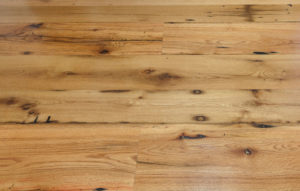
Wide Plank Floor Supply Reclaimed Oak Plank
Highlights: Reclaimed red and white oak flooring from old barns and other buildings in Pennsylvania, available unfinished in various thickness options as solid and engineered flooring. Very hardwearing with a Janka rating of 1290 or 1360.
Wide Plank Floor Supply offers beautiful reclaimed red and white oak flooring. The flooring comes from carefully dismantled barns and other buildings in Pennsylvania. This sustainable, reclaimed flooring is bursting with character, thanks to wormholes, mortise holes, peg holes, natural cracks and checks and an aged patina. You can order red and white oak together or separate to achieve your desired aesthetic.
The planks are available in face widths of 6-12 inches and as ¾-inch thick solid wood or engineered wood measuring 5/8-inch or ¾-inch thick. The planks come in boxes of different random lengths ranges, the smallest being 18 inches and the longest 10 feet.
These tongue and groove planks have a hardness rating of 1360 (white oak) or 1290 (red oak). Choose between pre-finished, as smooth milled face, or original face with all the character of reclaimed wood.
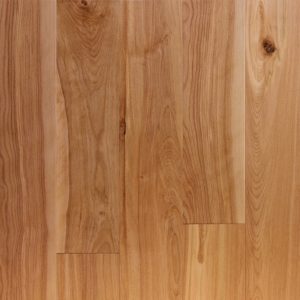
Fantastic Floor
Highlights: Affordable and quite durable hardwood flooring option that’s FSC certified.
Fantastic Floor offers a handful of affordable FSC certified flooring options in Red Birch. These include Select and Character Grade planks that are 3.25-inch and 5-inch wide and have a 4 mm top layer that allows for sanding and finishing at least a couple of times.
The finish contains aluminum oxide and the wood can be stained or unstained. Most of these options have an impressive Janka hardness rating of 1260 and you can nail, glue, or float the floors as desired. They are also suitable for radiant heat and you can install the prefinished, engineered flooring products over wood or concrete sub-floors. They are not suitable for damp areas, however.
It is unclear if these floors are CARB2 or E0 compliant and the company did not respond to my enquiries asking about certifications. The main reason I’ve included this company, then, is because the flooring is FSC certified, affordable, and durable.
Fantastic Flooring processes orders within 48 hours and has warehouses all across the U.S., making for fast shipping and delivery within 3-8 business days after shipment.